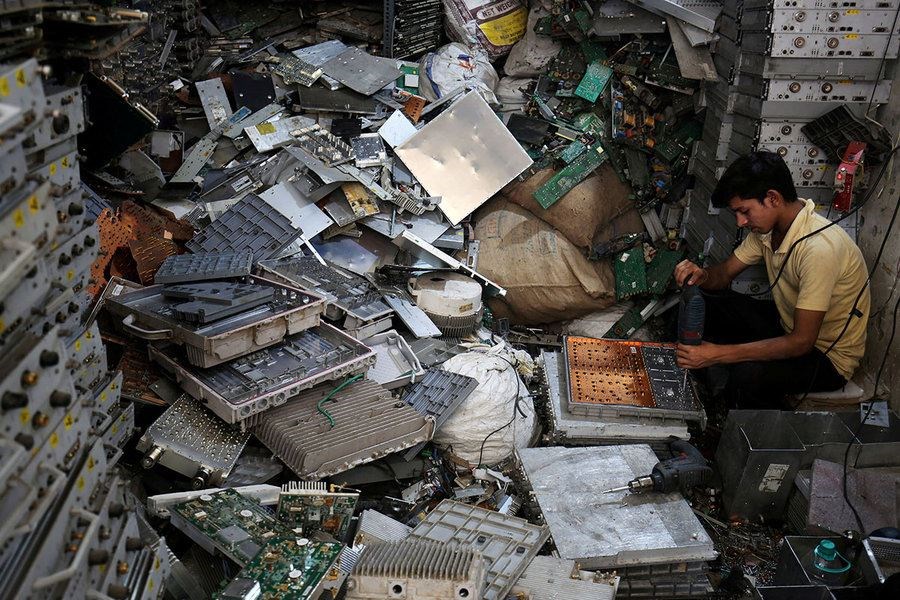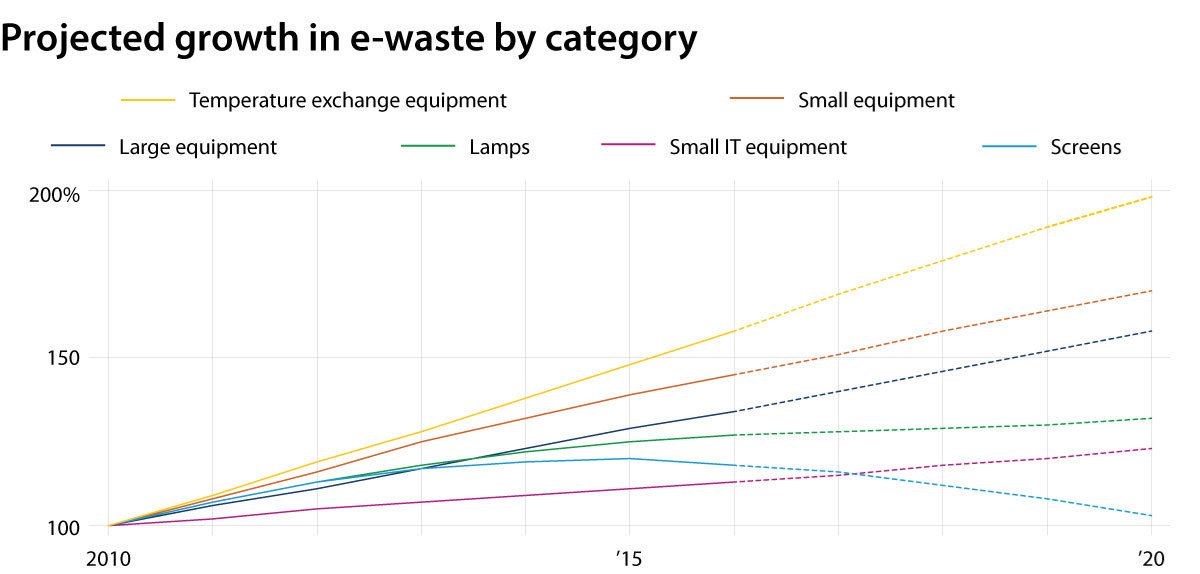Reprinted with permission from The Christian Science Monitor
The consumer push to own the latest electronic device has left an ever-growing wake of electronic waste. Country after country is passing legislation to regulate “e-waste” in order to protect their environments.
JULY 9, 2018
Q: What is e-waste?
A look around a reporter’s desk turns up eight items that will end up as e-waste one day: a printer, keyboard, computer screen, laptop, mouse, and phone charger, as well as mobile and landline phones. And a swivel of the desk chair brings into view a digital camera, television, and cable TV box.
 A worker dismantles electronic waste at a workshop in New Delhi, India, June 5, 2018. Worldwide, people threw away about 49 million tons of “e-waste” in 2016.Amit Dave/ReutersE-waste is an informal name for what is also called waste electrical and electronic equipment, or WEEE for short. It encompasses any household or office item at the end of its useful life that has circuitry inside, or electrical components drawing on a battery or power supply. Beyond the things in an office, e-waste denotes refrigerators, toasters, washing machines, stereo systems, electric toothbrushes, and the sort of toys that do things on their own.
A worker dismantles electronic waste at a workshop in New Delhi, India, June 5, 2018. Worldwide, people threw away about 49 million tons of “e-waste” in 2016.Amit Dave/ReutersE-waste is an informal name for what is also called waste electrical and electronic equipment, or WEEE for short. It encompasses any household or office item at the end of its useful life that has circuitry inside, or electrical components drawing on a battery or power supply. Beyond the things in an office, e-waste denotes refrigerators, toasters, washing machines, stereo systems, electric toothbrushes, and the sort of toys that do things on their own.
Worldwide, people threw away about 49 million tons of such stuff in 2016 – about 13 pounds for each inhabitant of the Earth. By 2021 that figure will have risen to more than 57 million tons, according to a study led by the United Nations University (UNU). It’s going up because more and more people can afford mobile phones and other electronic doodads and also because products do not last as long as they used to.
At the moment, only 20 percent of global e-waste is properly recycled and documented as such, says Pascal Leroy, head of the WEEE Forum in Brussels, an umbrella group for European producers and recyclers of e-waste. Nobody has a clear idea of what happens to the other 80 percent, though it is probably dumped, traded, or recycled dangerously in a developing country.
Q: Why is e-waste a problem, exactly?
For starters, e-waste contains a lot of poisonous chemicals. There is mercury in liquid-crystal display screens, lead in cathode-ray tubes, cadmium in semiconductors and batteries, and ozone layer-destroying chlorofluorocarbons in old refrigerators, for example.
 SOURCE: “The Global E-waste Monitor – 2017,” by United Nations University, International Telecommunication Union, International Solid Waste AssociationJacob Turcotte/StaffWhen e-waste is just dumped in a landfill untreated, those chemicals leach into the soil and water supply. If it is incinerated, they pollute the air. If it is shipped to a developing country where small-scale workshops try to recover the valuable components, the laborers are exposed to the poisons.
SOURCE: “The Global E-waste Monitor – 2017,” by United Nations University, International Telecommunication Union, International Solid Waste AssociationJacob Turcotte/StaffWhen e-waste is just dumped in a landfill untreated, those chemicals leach into the soil and water supply. If it is incinerated, they pollute the air. If it is shipped to a developing country where small-scale workshops try to recover the valuable components, the laborers are exposed to the poisons.
It is also a waste of valuable resources. WEEE contains gold, silver, copper, platinum, and palladium. Smartphones, in fact, are 30 times as rich in gold as ore dug from a gold mine. In all, the e-waste thrown away every year has an estimated $65 billion worth of raw materials in it, according to the UNU report. That’s more than the gross domestic product of some countries, and an El Dorado for “urban miners” seeking to extract value from trash.
Q: What happens to e-waste at the moment?
Good question. The data is sketchy.
The European Union, which has the strictest rules in the world, is aiming to properly collect and treat 65 percent of its e-waste by next year, but in reality it is currently only at 35 percent, Mr. Leroy says. Ten percent goes into household garbage, 40 percent ends up with scavengers and unregistered recyclers, 10 percent is shipped abroad as functioning secondhand equipment, and 5 percent is exported illegally.
In the United States, which has no federal law requiring e-waste takeback, 25 states have passed such legislation. That translates to 22 percent of US e-waste being accounted for and treated. “The whereabouts of the remainder of the e-waste is largely unknown in the USA,” says the UNU report.
 SOURCE: “The Global E-waste Monitor – 2017,” by United Nations University, International Telecommunication Union, International Solid Waste AssociationJacob Turcotte/StaffIn the past, a certain amount of it may have been shipped to China and other developing countries, since the US is not party to the Basel Convention, which regulates the trade in hazardous waste. But as of Jan. 1, China banned the import of plastic waste. Since almost all WEEE is embedded in plastic, that e-waste route has now been closed off.
SOURCE: “The Global E-waste Monitor – 2017,” by United Nations University, International Telecommunication Union, International Solid Waste AssociationJacob Turcotte/StaffIn the past, a certain amount of it may have been shipped to China and other developing countries, since the US is not party to the Basel Convention, which regulates the trade in hazardous waste. But as of Jan. 1, China banned the import of plastic waste. Since almost all WEEE is embedded in plastic, that e-waste route has now been closed off.
Q: What should consumers do with household e-waste?
In US states that have passed legislation, local governments should have set up e-waste collection points where consumers can drop off unwanted items. US laws are generally based on the concept of “extended producer responsibility,” which means electronics manufacturers are responsible for a product through its end-of-life treatment. Often, manufacturers pay for a contractor to manage statewide collection and recycling.
In Europe, which has made a “circular economy” a continent-wide goal, such collection points are common. And by law, electronics retailers are obliged to take any e-waste that a consumer brings into the store.
Retailers in the US have also been accepting items.
“The easier you make it for the consumers, the more likely they are to return their appliances,” says Leroy.
Page created on 7/11/2018 1:59:58 AM
Last edited 7/11/2018 2:16:17 AM
